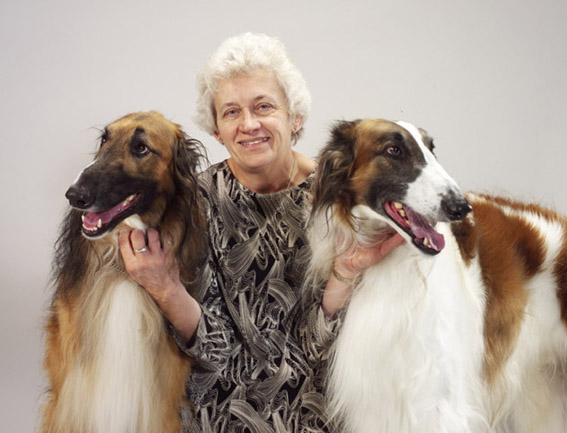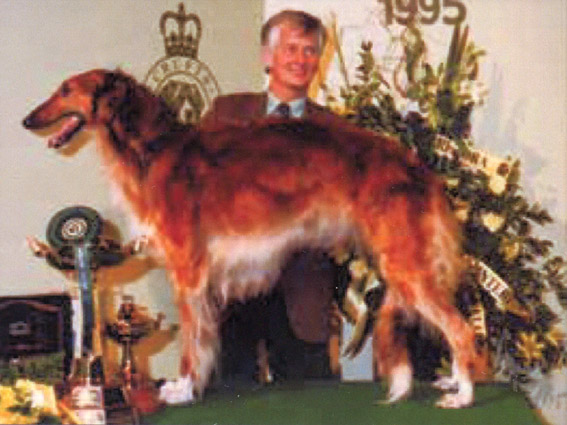
|
|
SPOTLIGHT ON THE BORZOI
SIGHTHOUND REVIEW SENT THESE QUESTIONS TO A NUMBER OF INTERNATIONAL
BREED-SPECIALIST JUDGES

1. Please briefly summarize your Borzoi involvement. When did you start judging? In which countries have you watched/judged significant Borzoi entries? Which other breeds/groups are you approved to judge?
My introduction to the breed came in 1965 while I was still at
school, and I acquired my first dog in 1971. My best-known male is Ch. Jolanda
Ivanhoe of Ryazan, and Ch. Ryazan
Heather and Ch. Ryazan Natasha are my best-known bitches.
I first awarded CCs in 1986 and I judge only Borzois. I have judged in Russia, America, Australia, Germany, Sweden and Slovenia, and next year will officiate in Finland, also at Crufts!
2.
Please mention the 4-5 Borzoi you have personally seen that you admired most
(not your own), and what their best features were. Any that you have only seen
in photos? Which one of your own was the best?
Among the dogs that I have greatly admired are Ch. Livny Black Eagle,
Ch. Stonebar Sebastian and Am. Ch. Teine Windmaster of Foxwood. They were all
correctly constructed, functional and very masculine dogs who nevertheless
retained the essential elegance of the breed. My all time favourite has to be
Ch. Sholwood Striking Rubies, such an exquisite elegant bitch with flowing lines
and excellent movement. From photos alone Ch Winjones Razluka and Ch. Winjones
Lebediska have always appealed. My choice among my own dogs is Ch. Ryazan
Heather.

3. Which one or two important characteristics do you feel are most often overlooked in Borzoi judging? Are there any “fads” that judges should be aware of?
Correct angulation of shoulder and particularly return of upper arm,
together with slope of pastern are often overlooked.
There are always fads eg for over refined heads, which would
compromise the dog’s ability to hold his prey, excessive coat, which masks the
dog’s outline in the show ring and would hinder him when hunting and over
angulated hindquarters, often with a steep croup, which can compromise the dog’s
movement. It is very important that any exaggerations are penalised by judges,
otherwise they will gradually become the norm for the breed, to its detriment.
4. What virtues do you think are most difficult to maintain in the breed and why? Which faults are the most difficult to eradicate?
I have found correctly constructed fronts to be the hardest virtue to
maintain and faults here the most difficult to eradicate, although it is
difficult to know why this should be so. Heads for example can be improved in
one generation, but it is essential to prioritise selection for sound front
construction with every litter bred.
5. What part of the AKC standard do you think is most misunderstood? Is there any part of the standard that you would change if you could? How does it compare with the FCI Borzoi standard?
The American standard gives a brief description of the breed but is
very short on detail, although the General Appearance clause is excellent. There
is no clause describing temperament, the description of the back is poor as it
does not identify the position of the highest point of the curve and there is no
mention of the desired front angulation other than that the shoulders should be
sloping. The English standard is written on the same lines and contains rather
more detail. The FCI standard is the most detailed of all, and the Important
Proportions clause at the beginning is excellent, but it can be rather difficult
to read and places an unnecessary emphasis on faults. A well written standard
should concentrate on the desired attributes of the breed and so make the
listing of faults unnecessary.
I consider the International standard to be the best of all, which is
hardly surprising as a number of enthusiasts have done a great deal of work on
it. They have attempted to incorporate much of the detail of the FCI standard
into the more easily assimilated format of the American and English standards.
Sighthound Review October